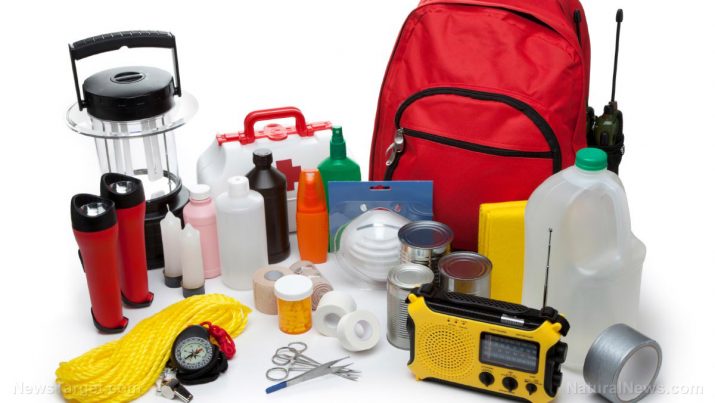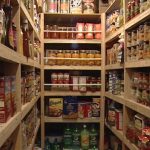
The art of minimalist prepping: Essential strategies for a simpler emergency plan
Wednesday, April 09, 2025 by Zoey Sky
http://www.naturalnewstips.com/2025-04-09-minimalist-prepping-essential-strategies-simpler-emergency-plan.html

- Prioritize learning practical skills like first aid, firestarting and navigation instead of hoarding expensive gear. Knowledge is lightweight, durable and irreplaceable.
- Stockpile foods you actually eat and rotate supplies to avoid waste. Store enough water for a few days and learn different purification methods.
- Buy essentials in bulk and thrift high-quality gear to save money. Avoid overbuying and focus on practicality.
- Prep for likely emergencies like power outages or natural disasters rather than extreme scenarios. Keep a lightweight bug-out bag with essentials.
- Build connections with neighbors and local groups for mutual support. Stay physically fit because strength, endurance and flexibility are critical in emergencies.
Prepping doesn’t have to mean filling your basement with tons of gear you won’t use, stockpiling a decade’s worth of food, or moving off-grid. In fact, the most effective preppers focus on simplicity, practicality and sustainability, not hoarding.
If you’ve ever dismissed prepping as too extreme or expensive, it’s time to reconsider. A minimalist approach ensures you’re prepared without sacrificing your current lifestyle.
Here’s a guide on how to become a minimalist prepper — i.e., someone who’s smart, efficient and ready for anything. (h/t to ModernSurvivalOnline.com)
Focus on skills, not gear
The best survival tool isn’t a $500 survival knife: it’s knowledge. Skills like first aid, firestarting, navigation and food preservation weigh nothing and can’t be stolen.
Instead of buying gadgets you’ll never use, invest time in learning:
- Basic medical training (first aid, CPR, etc.)
- Firestarting
- Foraging and gardening
- Hunting
- Navigation
- Shelter-building techniques
- Signaling
- Water purification methods
Once you know what you need, buy the related gear to support those skills.
Only store food you’ll actually eat
A common mistake? Stockpiling lima beans and canned tuna when you hate both. Survival food should be food you and your family enjoy eating. (Related: Pantry refresh: How to organize storable foods for easy, nutritious meals.)
If you wouldn’t eat it now, you probably won’t eat it in an emergency.
- Dried fruits (apricots, dates)
- Freeze-dried meals (ff you like them)
- High-energy bars
- Nuts (like almonds and macadamias, which are high in healthy fats)
Variety prevents menu fatigue, but practicality keeps you fed.
Optimize water storage and purification
Water is non-negotiable, but you don’t need a 500-gallon tank.
Before SHTF:
- Store a few days’ worth of bottled water (rotate your supply at least every six months)
- Use purification tablets
- Learn to filter water with a portable system
A minimalist approach means efficiency, not excess.
Buy supplies in bulk (when it makes sense)
Buying in bulk saves money and ensures you always have backups.
Focus on:
- Batteries (lithium batteries last longer)
- Rice, beans and oats (if you eat them)
- Medications (include things like allergy medication and other prescription meds for yourself or family members with health issues)
Check discount stores and online bulk retailers or ask local suppliers for deals.
Thrift shop for expensive gear
You don’t need a new $300 tactical backpack when a sturdy used one works.
Hunt for bargains at:
- Estate sales
- Facebook Marketplace
- Flea markets
- Thrift stores
A good-quality used item beats an overpriced new one.
Rotate perishable supplies (FIFO method)
Things like food, meds and batteries expire.
Use the “first in, first out” (FIFO) system:
- Eat the oldest food first, then replace items you use up with fresh stock.
- Check expiration dates on meds and batteries every three months.
The FIFO method helps prevent waste and ensures your supplies stay fresh.
Plan for likely disasters, not doomsday
Prepping isn’t always about the zombie apocalypse or nuclear fallout. Instead, it’s about realistic risks.
If you’re overwhelmed about where to start planning, ask:
- What natural disasters occur in your area? Are blizzards common? What about hurricanes?
- What emergencies could disrupt your daily life? Are you more worried about power outages or sudden job loss?
Focus on probable scenarios, not Hollywood movie catastrophes.
Keep a minimalist bug-out-bag (BOB)
A bug-out bag (BOB) is your emergency go-bag.
Keep it light but functional by only including essentials like:
- Water (a sturdy reusable water bottle with purification tablets)
- Food (energy bars, nuts)
- First aid kit
- Multi-tool
- Flashlight and extra batteries
- Warm layer and a rain poncho
Avoid overpacking because mobility is key when SHTF.
Focus on physical fitness
If you can’t walk a mile without gasping for breath, survival will get harder.
Fitness matters, and the following things will help you survive an emergency:
- Strength (carrying supplies, building shelter)
- Endurance (walking long distances)
- Flexibility (avoiding injuries)
If you’re out of shape, start small. Go on daily walks and try bodyweight exercises and stretching.
Build community connections
Lone wolves don’t survive when SHTF, but a strong prepper community does.
Strengthen ties with:
- Family (shared resources, support)
- Neighbors (mutual aid in emergencies)
- Local groups (prepping networks, skill-sharing)
Teamwork beats solo survival every time.
Don’t feel overwhelmed and remember that prepping isn’t about fear, it’s about confidence. By focusing on skills, smart storage and community, you’ll be ready for life’s disruptions without clutter or excess.
Check out Health Ranger Store and Brighteon Store to find prepping products for your stockpile. You can also visit Preparedness.news for more useful prepping tips.
Watch the video below to learn more about essential prepping toools like UHMWPE Braided Survival Cord and Bug Spray.
This video is from the Health Ranger Store channel on Brighteon.com.
More related stories:
Garden fresh: Low-effort planting and chemical-free pest control.
Survival 101: Effective EMF blocking techniques.
Prepping tips for beginners: Nutritious emergency foods to stock up on.
Sources include:
Tagged Under: Tags: emergency preparedness, emergency stockpile, Food storage, food supply, goodfood, homesteading, how-to, minimalism, minimalist, minimalist prepping, off grid, preparedness, prepper, prepper pantry, prepping, prepping stockpile, SHTF, survival, survival stockpile, tips
RECENT ARTICLES


The humble Potato: Nutritional benefits and how to enjoy it the healthy way
By Laura Harris

Building a prepper food stockpile on a budget: A practical guide for every household
By Zoey Sky

“Prepare Tribe: Prepare, Protect, Provide” on BrightU: Americans are dangerously unprepared for water emergencies
By Jacob Thomas

Cottage cheese: A superfood source of protein and other nutrients
By Laura Harris
COPYRIGHT © 2017 NATURAL NEWS TIPS


